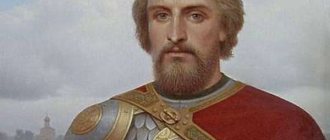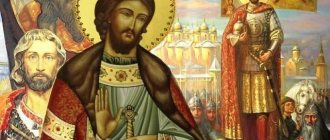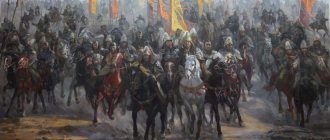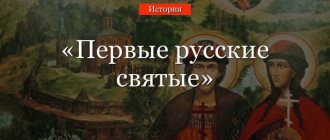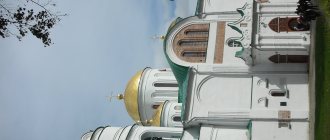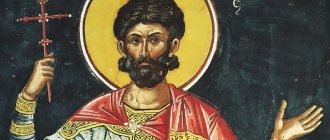Alexander Yaroslavich Nevsky was the prince of Novgorod, Kyiv and Vladimir. He became famous thanks to his victories over the Livonian Order and the Swedes. He played a subtle political game with the Horde and was able to protect his principality from the raids of Batu Khan. The prince died at the age of 42 in 1263, returning from another trip to the Horde. Most of Alexander's relics are kept in the Alexander Nevsky Lavra in St. Petersburg.
The cause of death of Alexander Nevsky was an illness that began during his stay in the Golden Horde. On November 14, 1263, returning to Vladimir, the prince died. Today, most of his holy relics are located in the Holy Trinity Alexander Nevsky Lavra.
Years of the prince's life
The date of birth of Alexander Yaroslavovich Nevsky is considered to be May 30, 1220. He was the second son of the Pereyaslavl prince Yaroslav. When his father went to reign in Kyiv, Alexander was left in Novgorod, where his activities as a ruler began. He was 15 years old then.
In 1249, Alexander became Prince of Kyiv. At 32, he received a gold label and became the Grand Duke of Vladimir. This happened in 1252, after Prince Andrei Yaroslavovich, frightened by another invasion of Tatar troops, fled to Sweden.
The most significant event in the life of Alexander, according to contemporaries, was the victory over the Swedish army on the Neva River in 1240, which subsequently gave him the nickname Nevsky. The second important battle was the Battle of the Ice in 1242, during which the knights of the Livonian Order were defeated and drowned on the ice of Lake Peipsi.
In 1238, Batu invaded Rus', as a result of which many Russian principalities came under the rule of the Mongols, but they did not capture Novgorod. Thus, Alexander Yaroslavovich remained more or less independent, but was forced to constantly negotiate with the khan. During his reign, he repeatedly went to the Horde to negotiate various matters relating to Russian lands. He pursued a policy of pacification, giving the Russian lands the opportunity to rest from the invasions of the Mongol warriors.
During another trip, he fell ill and died on the road. This happened on November 14, 1263.
Alexander Nevsky and Gorodets
The history of Gorodets, the oldest city in the Nizhny Novgorod Volga region, is closely connected with the name of Alexander Nevsky. Thanks to the painstaking work of researchers, we can trace this connection through the centuries through documents.
For the first time, Alexander Yaroslavich and Gorodets on the Volga are mentioned together in the Laurentian Chronicle in 1256. The Grand Duke of Vladimir Alexander Yaroslavich came to Gorodets to meet with his nephew Boris Vasilkovich of Rostov. The Rostov prince goes to the Horde, Alexander Yaroslavich, having sent gifts with him, leaves for the Novgorod land.
All ancient Russian chronicles record an event that occurred in Gorodets in 1263. Here is how it is recorded in the Novgorod Chronicle: “In the summer of 6771. Prince Oleksandris Tatar Velmi came to Gorodets and took monastic vows in the 14th month of November... That same night he introduced himself.” The Moscow chronicle reports this as follows: “The Great Prince Alexander went to the Horde to Tsar Berkai and, having kept him, the Tsar and Zimova in the Horde there, fell ill and went to Nizhny Novgorod and stayed for a short time and went to Gorodets and there fell into a greater illness and took a haircut. On November 14th Cherntsy, he reposed the same night, and carried his holy body to Volodymer.” The Patriarchal or Nikon Chronicle adds that the funeral of Alexander Yaroslavich took place in Vladimir on November 23, 1263. The prince was buried in the Church of the Nativity of the Blessed Virgin Mary. (Since 1724, the relics have been located in St. Petersburg in the Alexander Nevsky Lavra.) Having learned about the death of the prince, the Vladimir Metropolitan exclaimed: “The sun of the land of Suzdal is gone!”
The brave warrior and talented commander of the Novgorod squad Alexander Nevsky, having sat on the Vladimir throne in 1252, became a wise politician and a far-sighted diplomat, trying to prevent bloody skirmishes with the Mongols and ease the hardships of the yoke. And in 1262, he went to the headquarters of Khan Berke with rich gifts to prevent punitive campaigns of the Mongols on Russian lands (in 1262, a number of Russian cities refused to pay tribute to the Baskaks). Several months of a tense, dangerous life undermined the health of the Grand Duke. He died in the prime of his life (he was 42), but saved the Russian land from another ruin.
With the death of Alexander Nevsky, life in Rus' did not stop. After his death, his brother Yaroslav Yaroslavich became the Grand Duke of Vladimir. And the sons of Alexander received inheritances: the eldest - Dmitry - Pereyaslal and the right to the Vladimir throne, the middle - Andrey - Gorodets with his lands, the youngest - Daniil - Moscow. In 1282, the chronicles first mentioned the Principality of Gorodets, which was formed after 1263. The Principality of Gorodets included lands from Nizhny Novgorod to Unzha.
Andrei Alexandrovich is often called “Gorodetsky” in chronicles, although he was also the Great Prince of Vladimir. In chronicles there are quite often references to Andrei Gorodetsky. But almost all of them are connected with Andrei’s struggle with his older brother Dmitry for the grand-ducal table. The struggle took place with varying success (1281-1283, 1294-1304 - Andrei the Great Prince of Vladimir). In 1293, Andrei brought Dudenev’s army to Rus'. “A great army came against Grand Duke Dmitry, and the prince fled to Pskov. Tatarov took Vladimir, Pereyaslavl, Moscow, and only 14 cities and did a lot of evil in the Russian land.” Soon (1294) Dmitry died, and Andrei now legally ascended to the Vladimir throne.
Some researchers suggest that Gorodets on the Volga was Andrei’s favorite residence not only in moments of defeat, but also while “sitting” on the grand ducal table. The policies of Gorodets Prince Andrei Alexandrovich influenced the life of all North-Eastern Rus'.
Famous Russian historian V.A. Kuchkin believes that “at the end of the 13th century, Tver, Kostroma, Gorodets and Moscow were able to successfully claim the role of the center around which all of North-Eastern Rus' could unite in the future.” Moscow won, and Gorodets withdrew from the political struggle after Andrei’s death Alexandrovich. Prince Andrei died in 1304 and was buried in Gorodets in the Church of the Archangel Michael.
The Principality of Gorodets passed to Mikhail Andreevich, who ruled it until 1311. Historians still have not come to an agreement about who this Mikhail is: the son of Andrei Gorodetsky, or the son of Prince of Suzdal Andrei Yaroslavich (brother of Alexander Nevsky)? But this is not the point. Mikhail Andreevich did not have an heir. And we can confidently say that the following Gorodets princes were not direct descendants of Alexander Yaroslavich.
But it was not in vain that Nikolai Mikhailovich Karamzin called him the most popular prince of Ancient Rus', beloved by his contemporaries and revered by his descendants. Alexander was also revered by the townspeople. Through the centuries, they preserved the memory of the event of 1263 in church tradition, which tells that the holy noble prince Alexander Nevsky died in the Gorodetsky Feodorovsky Monastery. In 1700, the peasants of the Upper Sloboda asked Patriarch Adrian for permission to restore the monastery in Gorodets. In the petition they indicate that they want to build a monastery in the old cemetery, “where previously from ancient times there was the monastery of the Most Holy Theotokos of Feodorov, in which the blessed and Grand Duke Alexander Nevsky took monastic vows and reposed.” The Patriarch answered - “to be a monastery” and blessed the construction of a church in the name of the Holy Mother of God of Feodorov with the chapel of the Great Holy Blessed Prince Alexander Nevsky. The newly built monastery became the main place of veneration of the saint in Gorodets. One of the main shrines of the monastery was the icon of the blessed Prince Alexander with a particle of his holy relics. In 1798, a temple was built in the Gorodets monastery in the name of St. Blessed and Grand Duke Alexander Nevsky. In 1867, in honor of the blessed death of St. The noble prince opened the first school in the village at the monastery, and in 1869 the Alexander Nevsky spiritual and educational brotherhood. In 1871, a women's school was opened under the fraternity, which later moved into the zemstvo building. At the request of members of the Alexander Nevsky Brotherhood, a hospital with an emergency room and a pharmacy was opened at the monastery. And only later did a zemstvo pharmacy and emergency room appear in the village. In 1911, the archimandrite of the monastery Jeremiah, at the opening of the monument to Alexander II, expressed a desire to erect a monument to Alexander Nevsky in Gorodets. Unfortunately, the 20th century turned out to be tragic for the monastery. In 1927 the monastery was closed. The temple in the name of St. Alexander Nevsky was the last to be closed. It existed as a parish church until October 7, 1934.
But after a few years, to raise the feeling of patriotism, the Soviet government turned to the names of the great Russian commanders: Bogdan Khmelnitsky, Kutuzov, Nakhimov, Alexander Nevsky, Suvorov, Ushakov. Streets were named after them and awards were established.
In 1942, by decision of the Gorodets executive committee, Krasnoarmeyskaya Street in Gorodets began to bear the name of Alexander Nevsky. In the second half of the 20th century, visitors to the local history museum were shown a drawing of the Gorodetsky Feodorovsky Monastery as the place where the talented commander Alexander Nevsky died. And among the townspeople there was a keen desire to unveil a monument to the prince. In the 1980s, a bank account was even opened to collect donations. The monument appeared at a turning point for the country. On September 11, 1993, in the year of the 730th anniversary of the death of Alexander Nevsky, a monument to the Grand Duke was unveiled in our city using the personal funds of Nizhny Novgorod businessman Evgeny Vasilyevich Mamontov and other sponsors. The image of the prince, created by Nizhny Novgorod sculptor I.I. Lukin, the image of a warrior, defender of the Russian Land began to play a big role in the patriotic education of the townspeople. With the opening of the monument, for the first time in many years, holders of the Order of Alexander Nevsky began to be honored in Gorodets.
On September 10, 1995, City Day, delegations from Pereslavl-Zalessky, Vladimir, Pskov, Novgorod and St. Petersburg came to Gorodets for the holiday. On this day, a memorial stone was laid - a symbol of the unity of Orthodox Rus', a symbol of the unity of cities associated with the name of the holy noble prince Alexander Nevsky. Slabs were placed around the symbol stone, and under them were capsules with earth from cities, the history of which is connected together by the exploits and deeds of Alexander Yaroslavich Nevsky. The memorial is crowned with an inscription running around it - the spiritual testament of Prince Vladimir Monomakh: “All Russians should live in one heart.”
In 2000, next to the monument to the prince, a memorial dedicated to the Knights of the Order of Alexander Nevsky was opened. According to the latest specified data on the list of cavaliers - 18 names: Bulygin Arkady Ivanovich, Busarev Alexander Markelovich, Volgunov Gennady Dmitrievich, Vorozheykin Arseny Vasilievich, Gorbenko Anisim Yakovlevich, Grishin Alexander Andreevich, Kablev Fedor Stepanovich, Mazalov Vasily Mikhailovich, Martynov Alexander Nikolayevich, Novikinov Stupanov Stupanov Stupanov Stupanov Stupanov Stupanov Stupanov Stupanov, Novye Novikov, Novye Nikolayevich. HIV , Peredkov Christopher Andreevich, Petrov Pavel Nikolaevich, Prygunov Prokopiy Nikolaevich, Radonezhsky Nikolai Mikhailovich, Smetanin Pavel Petrovich, Khlebin Nikolai Alexandrovich, Cherepenin Pavel Evgenievich, Cheshev Mikhail Mikhailovich.
A real milestone for the revival of the memory of Alexander Nevsky on Gorodets land was the revival of the Feodorovsky Monastery, which again became the main place of veneration of the saint in Gorodets. The first stone for the foundation of the reconstructed cathedral in honor of the Feodorovsky image of the Blessed Virgin Mary on the territory of the monastery was laid on April 7, 2008, and on September 12, 2009, Patriarch Kirill consecrated the new temple.
On December 6, 2013, another historical event took place in the monastery: a monument to Alexander Nevsky was inaugurated, dedicated to the 750th anniversary of his death (November 14, 1263). This work by sculptor Peter Dobaev is unique in that for the first time in Russian monumental art the saint appeared not as a warrior, but as a humble monk.
Since 2012, the Cathedral “Alexander Nevsky – Glory, Spirit and Name of Russia” has been held in Gorodets. The timing of the Councils is dedicated to the memory of the prince in Gorodets and Vladimir: from his death to burial - from November 27 to December 6 (new style). According to tradition, these days in Gorodets end with a religious procession through the streets of the city from the monastery to the Volga embankment, to the Poklonny Stone and the monument to the prince.
Alexander Nevsky is an outstanding historical figure of Rus', and his personality occupies a special place in the history of Gorodets. Spiritually and symbolically, it unites the ancient and new Gorodets, the past and present. Grand Duke Alexander Yaroslavich “rested in Bose” on our land seven and a half centuries ago, but his noble image still lives in the memory of the townspeople.
Cause and place of death
The death of Alexander Nevsky occurred on the road from the Horde to Vladimir. During the long journey, he fell ill and died at the age of about 42 years. The exact place of his death is unknown today. Historians are divided in opinion, putting forward two assumptions regarding this:
- Volzhsky Gorodets is today the city of Gorodets in the Nizhny Novgorod region.
- Meshchersky Gorodets is today the city of Kasimov in the Ryazan region.
According to information from historical chronicles, Alexander felt unwell while still with the Tatars. Therefore, the possibility that he was poisoned cannot be ruled out.
The youth of a commander
Alexander was born on May 13, 1221. His hometown is Pereslavl-Zalessky. At the time of the birth of his son, the father of the family, Alexander Vsevolodovich, was the Prince of Pereyaslavl, and then of Kyiv and Vladimir. The mother of the future commander, Rostislava Mstislavovna, is a Toropetsk princess.
Sasha grew up in a large family. The boy had an older brother Fedya, who died at the age of 13. In total, the parents have 9 sons and 2 daughters. Some of them:
- Michael;
- Konstantin;
- Afanasy;
- Maria;
- Andrey;
- Daniel.
In 1225, little Sasha underwent an initiation ceremony and became a prince. The ceremony was held in the Transfiguration Church. When the boy was 9 years old, his father entrusted him and his brother with the management of Novgorod. 3 years later, Yaroslav's eldest son died, and Alexander became the only legal successor. The head of the family went to Kyiv in 1236, and then to Vladimir. Young Nevsky began to lead the city himself.
Where are the relics located?
The body of Alexander Nevsky, rubbed with salt and wax, was buried in the Vladimir Church of the Nativity of the Virgin. The Ark (of cancer) with its relics remained here until 1724, when Peter the Great issued a decree ordering the transfer of the holy remains to the new capital - St. Petersburg, to the Holy Trinity Alexander Nevsky Lavra.
Today, most of the relics of Alexander Nevsky are in the same place, but in addition to this they can be found in other churches:
- Temple of Alexander Nevsky in the capital of Bulgaria, Sofia.
- Assumption Cathedral in the city of Vladimir.
- Alexander Nevsky Church in the village of Shurala, Nevyansk urban district, Sverdlovsk region.
The memorial complex of the shrine in which they were kept is located in the Hermitage and is one of the main attractions of the capital, along with paintings by great artists. Today the exhibition is called a unique miracle of Russian decorative and applied art of the 18th century.
Attitude of contemporaries
Alexander was the prince of Novgorod, and later of Vladimir. The activities of his father Yaroslav caused discontent among the inhabitants of Rus', since Yaroslav collaborated with the Mongols. Nevsky, in turn, remained committed to this policy. The Orthodox Church supported the commander, because during the yoke it enjoyed sufficient freedom.
Alexander managed to obtain some concessions from the Mongols. For example, reducing the volume of tribute collected from Russians.
Alexander’s relations with Western countries did not work out. The prince responded with a sharp refusal to the offer to convert to Catholicism.
short biography
The biography of Alexander Nevsky is full of not only military exploits. This ruler was a successful politician. With amazing skill, he kept Rus' from dangerous attacks from the Catholic West and Mongol-Tatar troops.
First military campaigns
Alexander Yaroslavovich's first baptism of fire happened during a campaign with his father against the Livonian Order, which was besieging Dorpat. This campaign ended with the defeat of the enemy and the return of the city to Rus'. After this there was a successful battle with the Lithuanians for besieged Smolensk.
“We need to strengthen our defenses in the West and look for friends in the East,” these are the words put into the mouth of Alexander Yaroslavich, who won his first victories.
Battle of Neva
Thanks to the defeat of the Swedes in 1240, Alexander Yaroslavovich began to be called Nevsky. The content of the chronicles, restoring the chronology of the events of that day, shows the importance of the prince’s victory. It lies in the fact that Alexander Yaroslavich did not have the support of the main part of the army.
The sharply increased authority of the young prince frightened the Novgorod boyars. With the help of lies and deception, they ensured that the winner went to his father in Vladimir. At this time, German knights began to occupy their lands from the west.
Battle on the Ice
Returning to Novgorod, Alexander recruits his army with local people and advances to meet the Livonian Order. The meeting takes place on the shore of Lake Peipus on the western outskirts of the Pskov lands.
During the battle, which took place on the ice of a frozen reservoir, Alexander Nevsky used the following tactics. It consisted of luring knights dressed in heavy armor onto thin ice, where they drowned. Those who remained on the hard surface were attacked by lateral counterattacks of the cavalry and put to flight.
The result of this battle was the Order’s refusal to encroach on all recent conquests and the annexation of part of Latgale to the Novgorod land.
“Whoever comes to us with a sword will die by the sword. This is where the Russian land stands and stood! - a well-known phrase of the prince addressed to the defeated Swedish and German knights of the Livonian Order. In fact, this phrase is not mentioned in any historical document. It was invented by the writer P. A. Pavlenko, who wrote the script for the feature film “Alexander Nevsky” (1938).
Relations with the Tatar-Mongols
Realizing that he cannot resist the powerful Tatar-Mongol army, Alexander chooses a different way of relations. Unlike his brothers Andrei and Yaroslav, who opposed the yoke and were defeated, he goes to the Horde to bow to the khan and asks for his respect.
During the entire period of the reign of Russia (1247 - 1263), he repeatedly visited the Golden Horde and in every possible way supported the envoys of the khan who came to Rus' to collect tribute. Such two-sided political activity still causes controversy among historians:
- Some argue that his admiration for the yoke did not allow Rus' to develop.
- Others approve of his actions, characterizing the impossibility of waging war simultaneously against three opponents from different sides. Especially such a powerful enemy as the Mongol Empire was at that time.
Continuation of the family line
At the age of 19, Prince Alexander Yaroslavovich married the daughter of Vitebsk, and later Prince of Polotsk Bryachislav Polotsk, Alexandra. This happened in 1239, immediately after returning from the campaign, as a result of which Smolensk was liberated.
The first son of this marriage was born, Vasily, who later became the Prince of Novgorod. The second child was Dmitry, who reigned at different periods in Novgorod, Kostroma, Vladimir, and Gorodets.
The third was Daniel, appointed Prince of Moscow. There is practically no information about the daughter in historical chronicles, so apart from the fact that Evdokia became the wife of Konstantin Smolensky, nothing much is known.
Battle on the Ice
At the end of the summer of 1240, Livonian crusaders came to Pskov. The knights, after a short siege, took control of Izborsk. Then adherents of the Catholic faith, with the help of the boyars, occupied the city. Then came the invasion of Novgorod.
The Vladimir and Suzdal troops under the command of Alexander’s brother, Andrei, responded to the prince’s call for help. The united army went to Pskov land, having won this battle.
After the defeat, the crusaders, having formed a huge army, went on the attack again. The basis of their army was heavy cavalry and infantry. In the spring of 1242 there was the Battle of the Ice. It was under this name that the battle went down in history.
For a long time it was not possible to determine the location of the battle. The fact is that the hydrography of the lake changed several times, but historians later indicated the coordinates of the battle on the map. Scientists explained that the Rhymed Chronicle describes the massacre most accurately.
It states that there were many shooters in the city who took the knight's blow. The opponents lined up in a “pig” formation - a column that begins as a wedge. This helped the heavily armed cavalry to hit the Novgorodians. However, this strategy ultimately turned out to be wrong.
The prince's army remained in place while the Livonian pioneers tried to break through the infantry formation. Soon Nevsky's army struck the enemy's flanks, crushing the ranks of the Germans. The Novgorodians won.
Scientists claim that the German army included 14 thousand people , and the Novgorod militia included 15 thousand military personnel. Others consider such figures to be too high. The result of the battle put an end to hostilities. The Livonian Order abandoned the occupied territories. This battle played a big role in history.
The meaning of the holy image in history
After the death of Alexander Nevsky, he began to be revered as a saint, although the official canonization of his appearance occurred only in 1547. This happened not because of the military achievements of the prince, but because for Orthodox Christians he became famous for his sincere deep faith and virtues.
In particular, thanks to his efforts, the Christian faith spread to the lands of the northern Pomors and the first Orthodox diocese was created in the Golden Horde.
Interesting Facts
There were many significant events in the commander’s biography. Some facts from the life of Alexander Nevsky briefly:
- The man is the only Orthodox prince who did not make concessions to the Catholic Church to retain power.
- Films were repeatedly made about the life of the commander. In 1938, the most famous film of the same name was released. Sergei Eisenstein was the author and director of this film. In addition, a famous Soviet composer wrote a choral cantata, naming it after the prince.
- In 2008, a competition called “The Name of Russia” was held. The latter organized one of the country's television channels. Internet users chose the winner from the list of “500 great figures.” As a result, Joseph Vissarionovich Stalin became the leader. The creators said that “spammers” voted for it. As a result, the commander was named the favorite.
- The man won his main military victories in his youth. During the Battle of the Neva he was 20 years old, at the time of the Battle of the Ice - 22. Over time, Alexander was called a politician, but was more considered a military leader.
- After the man’s death, “The Tale of the Life of the Grand Duke” appeared, a hagiographic work written in the 80s of the 13th century.
Alexander Nevsky is a popular figure in history, a great Russian prince, and a talented commander. For many years, the man has been considered a national hero, a true patriot, a guardian of Orthodoxy and the freedom of the people.
Miracles after death
It was decided to bury the ashes of the deceased in nearby Vladimir. It took the squad 9 days to get to the city. Already during the journey, miraculous events began to occur, which later prompted the church to the need to canonize the saint. For 9 days the body did not begin to decompose.
When, during burial in the monastery, Metropolitan Kirill tried to unclench Alexander’s fingers in order to insert the letter, the saint extended his hands to the paper and accepted it. All those present were gripped by horror.
Ordinary people from all over began to come to venerate the relics of the ruler. Many of them asked for healing and received recovery. The fame of the miracles being performed quickly spread beyond the boundaries of the Nativity Monastery.
